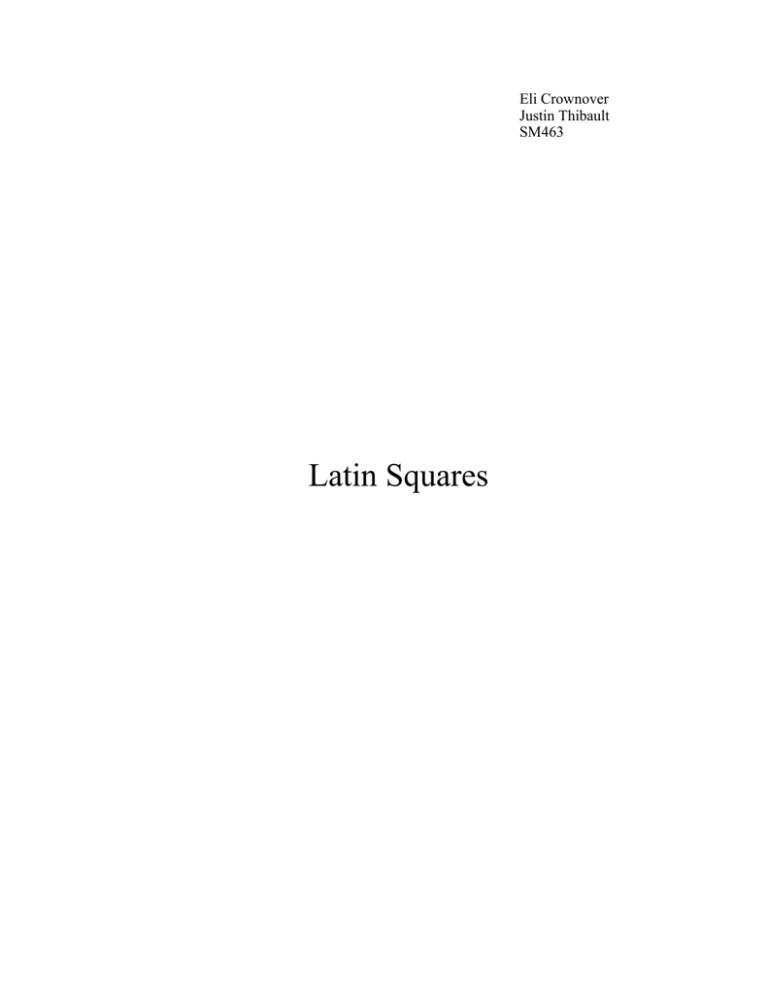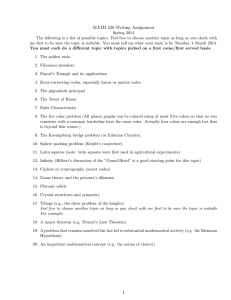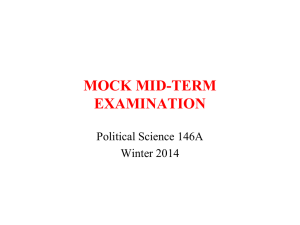Latin Squares Eli Crownover Justin Thibault SM463
advertisement

Eli Crownover
Justin Thibault
SM463
Latin Squares
A Latin square of order q is a qxq array whose entries are from a set of Fq of q
distinct symbols arranges in such a way that each symbol occurs exactly once in each
column and exactly once in each row.1 An example of this would be the following:
A Latin square of order 3 where F3 = {1,2,3}. The resulting Latin square would be
123
231
312
123
312
231
or
This is very useful in statistics. For example, if a pharmaceutical company wanted
to test 4 headache drugs on 4 different patients for 4 successive days. A Latin square can
be used in order arrange to which patient takes which drug on which day. The end result
is that each patient will take each drug only once and no drug will be taken more than 1
patient on a given day. For example:
The days are Monday, M, Tuesday, T, Wednesday, W, and Thursday, R.
4 Patients labeled A, B, C, D and 4 drugs labeled 1, 2, 3, 4.
A possible resulting schedule would be as follows:
A
B
C
D
M
1
2
3
4
T
2
1
4
3
W
3
4
1
2
R
4
3
2
1
This allows for the testing of the different drugs on different subjects and allows
for some measurement of the drugs’ effects when taken on different days of the 4-day
period.
A simple theorem for Latin squares exists regarding the number of elements in the
square. It states
“There exists a Latin square of order q for any positive integer q.”
1
A First Course in Coding Theory: Hill, Raymond. Clarendon Press, 1986
The proof of this is done simply by starting with a row of numbers 1 2…..q and
cycling it by 1 space for each following row. The result is this:
1
2
3
·
·
q
2
3
4
·
·
1
3···
q
4··· q 1
5 · · ·q 1 2
·
·
·
·
2 · · · q-1
This shows there is a Latin square for any positive integer q.
Mutually Orthogonal Latin Squares, or MOLS, are a very useful tool. Two Latin
squares are considered to be mutually orthogonal when they have the same dimension
and unique ordered pairs are made from their corresponding elements.2 In other words, if
you have 2 Latin squares A and B, both of dimension n, and we superimpose A over B,
we get a new square whose elements are ordered pairs. When all of these ordered pairs
are unique, the 2 original Latin squares are considered to be mutually orthogonal. The
following is an example of this:
1 2 3
A= 2 3 1
3 1 2
1 2 3
B=3 1 2
2 3 1
When ordered pairs are made from the elements of each square with the same
coordinates the result is
(1,1) (2,2) (3,3)
(2,3) (3,1) (1,2)
(3,2) (1,3) (2,1).
Note that every ordered pair is unique.
An application of this would be with once again the experiment conducted by the
pharmaceutical company. This time, however 2 drugs will be tested together. Here there
are 3 types of headache drugs and 3 types of fever drugs. The question is, “can a there be
2
A First Course in Coding Theory: Hill, Raymond. Clarendon Press, 1986
a schedule in which all 9 combinations of drugs are tested only 1 time?” The answer is
yes, by use of MOLS. Two separate schedules are made, one for each drug. Then one is
superimposed onto the other.
For years work has been conducted on orthogonal Latin squares. In the 1960’s a
famous conjecture written by Leonhard Euler had been proven false after 100 years of
work. It was then that mathematicians all over began constructing Latin squares. One of
which was W. McWorter. The conjecture was that no orthogonal Latin squares existed
for the order 4n+2. It was proven false by Bose, Shrikhande, and Parker, with the
exception of order 6 as proven by Gaston Tarry in 1900.3
Gaston Tarry
4
3
4
http://www.cut-the-knot.org/arithmetic/latin3.shtml
http://www-history.mcs.st-andrews.ac.uk/PictDisplay/Tarry.html
With the dispute over the conjecture settled the new challenge was to find how
many orthogonal squares there were for a given order. As it turns out, there are up to n-1
for a given order n.5
There are several theorems that expand on the nature and possibility of Latin
squares. Here, however, we will dive into an application to coding theory.
One such theorem is as follows: There exists a q-ary (4, q2, 3)-code iff there exists a pair
of MOLS of order q.
Proof: We will show that a code C = {(i, j, aij, bij) | (i, j) є (Fq)2} is a (4, q2, 3)code iff A = [aij] and B = [bij] form a pair of MOLS of order q. The minimum distance of
C is 3 iff, for each pair of coordinate positions; the ordered pairs appearing in those
positions are distinct. The q2 pairs (i, aij) are distinct and the q2 pairs (j, aij) are distinct iff
A is a Latin square. The q2 pairs (i, bij) are distinct and the q2 pairs (j, bij) are distinct iff B
is a Latin square. The q2 pairs (aij, bij) are distinct iff A and B are mutually orthogonal.
This shows that Aq(4, 3) = q2 there exists a pair of MOLS of order q.6
http://www.cut-the-knot.org/arithmetic/latin.shtml
A First Course in Coding Theory: Hill, Raymond. Clarendon Press, 1986
5
6
Works Cited
1. http://www.cut-the-knot.org/arithmetic/latin3.shtml
2. http://www-history.mcs.st-andrews.ac.uk/PictDisplay/Tarry.html
3. A First Course in Coding Theory: Hill, Raymond. Clarendon Press, 1986.





